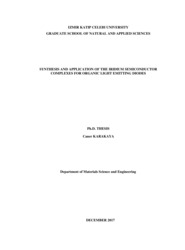Synthesis and application of the iridium semiconductor complexes for organic light emitting diodes
- Tez Danışmanı Şerafettin DEMİÇ
-
Tür
Doktora Tezi
- Yayın Tarihi 2017
-
Yayıncı
İzmir Katip Çelebi Üniversitesi Fen Bilimleri Enstitüsü
- Tek Biçim Adres Http://hdl.handle.net/11469/366
Organic light emitting diodes (OLEDs) is a multi-disciplinary research area. Due to the possibility of being produced in different designs and low costs, studies on the research and development of energy efficient structures have increased. These expectations have increased so much that research on new types of molecules and device designs is increasing with the expectation that OLEDs will be more efficient than all available light sources and that almost 100% of the energy used can be converted to light. Transition metal complexes, especially Iridium(III) complexes, which make them phosphorescent due to their high quantum yield and broad emission colors, have been the most widely used emission material for OLED applications. Because the materials with this property provide both singlet and triplet transitions, all excited states contribute to light emission, so the theoretical internal quantum yield of these complexes can reach 100%.
In this work, 4 spiro-based ligands were synthesized by Suzuki cross-linking methodology and 8 novel Ir(III) complexes were synthesized with these ligands. The synthesized molecules were characterized by 1HNMR, 13CNMR, UV-Vis, photoluminescence (PL) and cyclic voltammetry (CV) techniques.
Ir(III) complexes have been prepared functionalized as two series. The photophysical properties of the functionalization have been examined to determine the effect on the emission. It was determined that complexes with solution phase emission studies had green and orange emissions ranging from 510 to 578 nm with the effect of functionalized electron donating group (EDG) and electron withdrawing group (EWG) groups. These results showed that substituent groups are effective on the emission of complexes. The results from cyclic voltammograms show that EDG and EWG groups and complexes have different energy band intervals (Eg value).
Some of the synthesized iridium complexes were made with a light emitting device (single active layer OLED, light emitting electrochemical cell, LEC device). It has been observed that these devices can operate at low voltages. LEC devices were prepared in the ITO/PEDOT:PSS/Ir(III)complex/Ag configuration. It was determined that the prepared LEC devices started to radiate at on average of 5.5 V and the highest luminance value (in C2 complex) was measured as 1107 cd/m2.
-
Koleksiyonlar
ENSTİTÜLER
FEN BİLİMLERİ ENSTİTÜSÜ

 Tam Metin
Tam Metin

